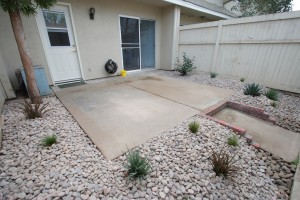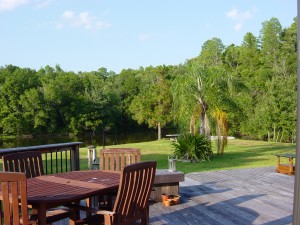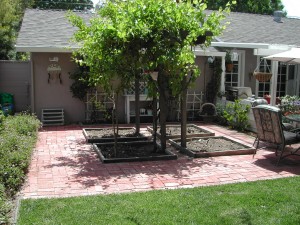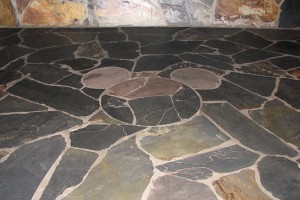Summary: The Patio or Terrace is an area many homeowners live (weather permitting) during the year. In this article we will look at some of the different patio flooring materials and options available to homeowners today.
Patio floors like most things can be done in more than one way, and the difference is not necessarily between good and bad work.
Sometimes a method that would be rough under one set of conditions is perfectly acceptable under another.
Even in fine work, practice varies under different conditions and between different artisans.
The homeowner proposing to do elaborate work on their patio/terrace “creation” is urged to consult and become familiar all phases of construction in great detail. You’ll discover flooring materials and designs, along with a few points that are controversial, and to others that are often overlooked.
Patio Economy Rarely Pays
When a patio or terrace is to have rough or constant use, economy at the time of making it is rarely – economy in the long run. Actually, the investment in a quality patio can increase property value.
Gravel & Landscape Stone
Gravel, crushed stone and grass are relatively inexpensive, but gravel and crushed stone are poor surfaces for garden furniture, besides being easy to track debris into the house.

Grass needs constant attention, and, in a much used area, can be a source of domestic friction, when the gardener’s plea to keep off it during periods of renovation falls on deaf ears.
For a temporary surface, if the budget does not permit permanent paving, bark is an excellent material; it does not become sticky when it is wet and it is pleasing to look at.
Wood Bricks and Decking
Wood can be a very satisfactory paving material. You can find some beautiful garden books and magazines lavishly illustrated with pictures of handsome outdoor floor designs. An objection to some using wood “decking” or flooring which the boards are spaced and raised is that pointed heels catch; it is also amazing how many “items” can slip through a small crack.

Wooden blocks set directly on the ground, unless packed very close together and tamped absolutely level, are difficult to sweep. This type of paving is often pictured with an appreciable earth-filled gap between blocks; this may not be satisfactory for an outdoor living room close to the house.
When wooden block paving is used, it should be edged with a strong curb to hold it firmly in place and prevent individual blocks from becoming loose. The curb may be of stone, brick, boards, logs, or wooden blocks set on end.
Occasionally one sees an outdoor wood terrace paved with blocks cut hexagonally by some craftsman long ago and fitted as closely and carefully as ceramic tile. I’ve seen images of such a paving in Australia, made of jarrah. After a hundred years, it was flawless.
Indeed, it is questionable whether it would be particularly appropriate for an outdoor living room, but it is an interesting example of the use to which wood is sometimes put. New “wood-like” materials called “composite wood” may, in the future change the way wood is used on the patio/terrace as this composite wood does not rot.
The most durable materials for paving a terrace are brick, native stone, cut or broken flagstone, and concrete.
Landscape Brick
Brick and landscape pavers is somewhat tedious to lay, but it possesses a quality that is lacking in every other material and its appearance improves with age. In fact, probably no paving material mellows more handsomely with age, and it is positively difficult to make work with old weathered brick look shoddy.
When it is wet, the color is rich and satisfying and the texture never clammy. Since it does not radiate heat, it is good for hot climates. In cold climates, it looks much warmer than slate-colored flagstone.
The difference between brick laid dry on a bed of sand, overlying a bed of cinders or gravel, and brick laid in mortar, may be compared to the difference between hand-woven and machine-made cloth, and there are landscape architects who engage in a perpetual battle with masons and clients who want every bit of brickwork laid in mortar.

However, when the floor is to be used for dancing, or when there are children with roller skates and tricycles, the use of mortar is necessary. The point to remember is that the two methods produce a totally different effect and that when traffic is heavy another type of paving may be preferable.
Landscaping bricks laid dry should be packed as tightly as possible. Even with sand brushed into the cracks, the bricks will wobble if they are not laid tight; also, the sand washes out and is objectionable.
The edging must be absolutely solid. If it is made of brick, it may be advisable to use mortar for the marginal course; much depends upon the amount of traffic.
The foundation for bricks laid in mortar should be three to four inches thick. Don’t, however, lay the bricks directly on a “sloppy wet” foundation; it will be almost impossible to keep the surface of the bricks even. Instead, roughen the surface of the foundation and allow it to set.
Then spread a mixture of two parts of sand and one part of cement over the foundation, in a layer about an inch thick. Sprinkle the sand-cement mixture lightly with water, a small area at a time, and lay the bricks on it, packing them tight and tamping each one carefully in place.
Fill the cracks with the same mixture, and wash off the excess. The sand-cement mixture will bond with the underlying concrete and set into a rigid base for the brick. When the whole terrace is laid, clean off any fragments of mixture still adhering to the surface with muriatic acid.
When you are laying the bricks, keep the pattern straight by putting a line of cord across the terrace from one side to the other, pegging it firmly. Follow the line as you would if you were planting vegetable seed.
Stone
Stone can be random rectangular flagstone, broken flagstone, or native stone.
Flagstones vary a great deal in thickness. Heavy stones three inches and more thick may be laid directly on the earth even in severe climates. Thinner flags laid dry should have a base of sand overlying gravel or cinders.

Flagstones laid dry must be packed very tightly to prevent grass growing between the cracks. No matter how tightly they are laid, however, the heels fashionable today are so pointed that they have a tendency to catch. If the terrace is to be used for dancing, this may be a serious objection.
If cement is used, the thorough way is to lay the stone in a concrete bed, but many masons simply pour mortar, which can be colored to match the stone, between the cracks.
Since the mortar may be expected to crack as the large stones settle, and during periods of thawing and freezing, perfectionists regard this practice with horror; but it is much less expensive and much simpler than laying the flags in a concrete bed, and it is easy to repair cracks with ready-mix concrete.
Admittedly, a flagstone terrace in which cement is used does not have the fine, hand-made look of one laid dry, but if the work is carefully done, the effect is not displeasing.
Irregular pieces of flagstone are almost impossible to use for a terrace without cement, unless the area is very rough.
It is much more difficult to make a good-looking paving with broken flagstone than with random rectangular pieces. Broken flagstone and native stone laid dry are most satisfactory when the spaces are filled with mat-like plants.
Cast Stone
Pre-cast concrete blocks of irregular size are much more pleasant to look at than a smooth unbroken surface of concrete. Whenever concrete is used, however, the appearance of the terrace or patio is improved if some other material is introduced.
Bricks or wooden blocks can be used to make an interesting pattern. If they are laid first, they will serve as forms for the concrete mix.
One of the most effective materials to combine with concrete is a coarse aggregate made of pebbles set in a concrete mix. This is especially recommended in areas where the soil yields quantities of smooth pebbles of a suitable size and color. This condition often exists near the shore, in sections that have been under glaciation, and in old river valleys.
The coarse-aggregate blocks can be pre-cast, or made at the same time as the terrace/patio. They require more patience, of course, than a plain concrete surface; but properly used they give dignity and distinction to what might otherwise be a very dull paving.
Pine Needles and Wood Chips
All these materials make a pleasing floor for an outdoor living room. Remove any stones from the area to be covered, level it, roll or tamp it, and cover it to a thickness of about two inches with the paving material.
Brick, board and railway ties make good edgings for this type of “paving”.


Comments on this entry are closed.